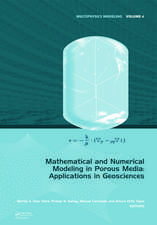Numerical Computation 1: Methods, Software, and Analysis
Autor Christoph W. Ueberhuberen Limba Engleză Paperback – 27 feb 1997
Preț: 402.00 lei
Nou
Puncte Express: 603
Preț estimativ în valută:
76.93€ • 80.68$ • 64.04£
76.93€ • 80.68$ • 64.04£
Carte tipărită la comandă
Livrare economică 01-15 aprilie
Preluare comenzi: 021 569.72.76
Specificații
ISBN-13: 9783540620587
ISBN-10: 3540620583
Pagini: 496
Ilustrații: XVI, 474 p. 31 illus.
Dimensiuni: 155 x 235 x 26 mm
Greutate: 0.74 kg
Ediția:1997
Editura: Springer Berlin, Heidelberg
Colecția Springer
Locul publicării:Berlin, Heidelberg, Germany
ISBN-10: 3540620583
Pagini: 496
Ilustrații: XVI, 474 p. 31 illus.
Dimensiuni: 155 x 235 x 26 mm
Greutate: 0.74 kg
Ediția:1997
Editura: Springer Berlin, Heidelberg
Colecția Springer
Locul publicării:Berlin, Heidelberg, Germany
Public țintă
ResearchCuprins
1 Scientific Modeling.- 1.1 Reality Versus Model.- 1.2 The Model Subject and the Model.- 1.3 The Model Subject and Reality.- 1.4 Model Building.- 2 Fundamental Principles of Numerical Methods.- 2.1 From Application Problems to their Numerical Solution.- 2.2 Numerical Problems.- 2.3 Types of Errors in Numerics.- 2.4 The Condition of Mathematical Problems.- 2.5 The Condition of Application Problems.- 2.6 The Mathematical Elements of Condition Estimation.- 2.7 Validation of Numerical Computations.- 3 Computers for Numerical Data Processing.- 3.1 Processors.- 3.2 Memory.- 3.3 Performance Quantification.- 3.4 Analytical Performance Assessment.- 3.5 Empirical Performance Assessment.- 4 Numerical Data and Numerical Operations.- 4.1 Mathematical Data.- 4.2 Numerical Data on Computers.- 4.3 Operations on Numerical Data.- 4.4 Number Systems on Computers.- 4.5 Structure of Floating-Point Systems.- 4.6 Standardization of Floating-Point Number Systems.- 4.7 Arithmetics for Floating-Point Systems.- 4.8 Inquiry Functions and Manipulation of Numbers in Fortran 90.- 4.9 Operations with Algebraic Data.- 4.10 Operations with Arrays.- 4.11 Operations with Analytic Data.- 5 Numerical Algorithms.- 5.1 The Intuitive Notion of an Algorithm.- 5.2 Properties of Algorithms.- 5.3 Existence of Algorithms.- 5.4 Practical Solvability of Problems.- 5.5 Complexity of Algorithms.- 5.6 Representation of Algorithms.- 5.7 Influence of Rounding Errors on Numerical Algorithms.- 5.8 Case Study: Floating-Point Summation.- 6 Numerical Programs.- 6.1 The Quality of Numerical Programs.- 6.2 Reasons for Poor Efficiency.- 6.3 The Measurement of Performance Indices.- 6.4 Performance Optimization.- 6.5 Architecture Independent Optimizations.- 6.6 Loop Optimizations.- 6.7 Blocked Memory Access.- 6.8 Case Study: Multiplication of Matrices.- 7 Available Numerical Software.- 7.1 The Cost of Software.- 7.2 Sources of Numerical Software.- 7.3 Software and the Internet.- 7.4 Interactive Multifunctional Systems.- 7.5 Problem Solving Environments.- 7.6 Case Study: Software for Elliptic PDEs.- 8 Using Approximation in Mathematical Model Building.- 8.1 Analytic Models.- 8.2 Information and Data.- 8.3 Discrete Approximation.- 8.4 Function Approximation.- 8.5 Choosing a Model Function.- 8.6 Choice of the Distance Function.- 8.7 Transformation of the Problem.- 9 Interpolation.- 9.1 Interpolation Problems.- 9.2 Mathematical Foundations.- 9.3 Univariate Polynomial Interpolation.- 9.4 Univariate, Piecewise, Polynomial Interpolation.- 9.5 Polynomial Splines.- 9.6 B-Splines.- 9.7 Cubic Spline Interpolation.- 9.8 Splines Without Undesirable Oscillations.- 9.9 Multivariate Interpolation.- 9.10 Multivariate Polynomial Interpolation.- 9.11 Multivariate (Sub-) Spline Interpolation.- 9.12 Related Problems and Methods.- Glossary of Notation.- Author Index.
Recenzii
"The two volumes can be highly recommended for newcomers in the area as well as for people working for a long time in or with computer numerics." - EUROSIM - Simulation News Europe
"...This book is highly recommended to students, scientists, and engineers interested in the numerical solution of mathematical problems. It is very useful as a handbook for both newcomers and experts. Every science/engineering\-/mathematics/computer science library should have a copy of this book."--MATHEMATICAL REVIEWS
"...This book is highly recommended to students, scientists, and engineers interested in the numerical solution of mathematical problems. It is very useful as a handbook for both newcomers and experts. Every science/engineering\-/mathematics/computer science library should have a copy of this book."--MATHEMATICAL REVIEWS











